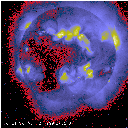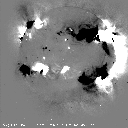Curious if not spectacular N-S loop phenomena
Science Nugget: May 14, 1999
Introduction
We've devoted several past science nuggets to the behavior of large-scale
magnetic loops that connect the northern and southern solar hemispheres.
As fans of this subject will recall, such structures don't readily occur
in standard scenarios for solar magnetism beneath the photosphere,
whence it all originates. Thus one needs to appeal to magnetic reconnection
in the corona (or just below it, where the gas can readily stress the field;
or from the outer corona, where the solar wind can stress it). For reference
material in the Yohkoh context, see the earlier science nuggets
by following the trail from the discussion of trans-equatorial
loops from last month. In the present nugget, we describe two relatively
minor but interesting developments in the NS loop structure that developed
this week.
An X-shaped configuration
| The image on the right shows the general location of the X-shaped feature.
This geometry calls to mind 2D pictures of magnetic reconnection at a neutral
point. Here the left branch has a cusp pointing to the west, generally
in the direction of the local vertical; the right branch would have a cusp
(however) pointing to the east, which means that it is highly inclined.
Probably both cusped loops have large inclinations and are low-lying. |
 |
We have made the time variations of this structure in to a movie
of a few hours' duration:

which shows some of the dynamics. In particular it appears that the
right cusp element (idealizing the geometry as an X for which the left
and right sides don't quite meet) actually exhibits flows along
its length, from south to north. This suggests that the "re-formation"
of NS interconnecting loops, a term often used by Z. Svestka, might result
from siphon flow or "evaporation" along basically stable magnetic structures.
The "re-formation" would then be interpreted as a "re-illumination."
A bright cusp following a flare
Earlier in the week, on May 9, a rather nice cusp formed in the same general
region, following a major LDE flare event in the active complex to the
north. We show this as a movie:

The initial frame shows some of the flare, plus a lot of the saturation
and other systematic effects in the SXT detector that we don't normally
make public. Note the time jump. On the day after the flare, the cusp appears,
and it grows to the E in the usual pattern. This seems like a textbook
case of post-flare loop formation following a CME eruption, with the remark
here that the CME must therefore have involved the entire heliospheric
current sheet, as one frequently observes in the LASCO
data.
Conclusion
We think we're learning things from watching these NS interconnecting loops.
But what? Surely we see the results of reconnection, which is an inherently
interesting physical process, but under what conditions is the reconnection
taking place, why, and what results from it? No doubt the answers to these
questions will help considerably in understanding how the complex "raw"
magnetic field of the photosphere is cooked by the corona into the relatively
simple solar-wind field morphology.
Note added in proof: today (May 14) this NS interconnecting structure
has been developing interestingly. Glad we've been watching it!
Well (note added 5/17), the story did continue interestingly. Below
is a difference image comparing May 15 (black) with May 17 (white), on
a slightly exaggerated color display. It shows that, sure enough, the W
limb did light up as the interconnecting loops re-formed beautifully!

May 14, 1999: Hugh Hudson
(hudson@isass0.solar.isas.ac.jp)

